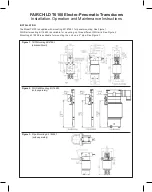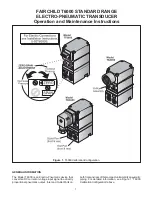
CC2500
SWRS040C
Page 20 of 89
Transmit mode
Receive mode
Idle
Manual freq.
synth. calibration
RX FIFO
overflow
TX FIFO
underflow
Frequency
synthesizer on
SFSTXON
SRX or wake-on-radio (WOR)
STX
STX
STX or RXOFF_MODE=10
RXOFF_MODE=00
SFTX
SRX or TXOFF_MODE=11
SIDLE
SCAL
SFRX
Idle
TXOFF_MODE=00
SFSTXON or RXOFF_MODE=01
SRX or STX or SFSTXON or wake-on-radio (WOR)
Sleep
SPWD or wake-on-radio (WOR)
Crystal
oscillator off
SXOFF
CSn=0
CSn=0
TXOFF_MODE=01
Frequency
synthesizer startup,
optional calibration,
settling
Optional freq.
synth. calibration
Default state when the radio is not
receiving or transmitting. Typ.
current consumption: 1.5mA.
Lowest power mode. Most
register values are retained.
Typ. current consumption
400nA, or 900nA when
wake-on-radio (WOR) is
enabled.
All register values are
retained. Typ. current
consumption; 0.16mA.
Used for calibrating frequency
synthesizer upfront (entering
receive or transmit mode can
then be done quicker).
Transitional state. Typ. current
consumption: 7.4mA.
Frequency synthesizer is turned on, can optionally be
calibrated, and then settles to the correct frequency .
Transitional state. Typ. current consumption: 7.4mA.
Frequency synthesizer is on,
ready to start transmitting.
Transmission starts very
quickly after receiving the
STX command strobe.Typ.
current consumption: 7.4mA.
Typ. current consumption:
11.1mA at -12dBm output,
15.1mA at -6dBm output,
21.2mA at 0dBm output.
Typ. current
consumption:
from 13.3mA (strong
input signal) to 16.6mA
(weak input signal).
Optional transitional state. Typ.
current consumption: 7.4mA.
In FIFO-based modes,
transmission is turned off
and this state entered if the
TX FIFO becomes empty in
the middle of a packet. Typ.
current consumption: 1.5mA.
In FIFO-based modes,
reception is turned off and
this state entered if the RX
FIFO overflows. Typ.
current consumption:
1.5mA.
Figure 5: Simplified State Diagram with Typical Usage and Current Consumption at 250 kBaud
Data Rate and
MDMCFG2.DEM_DCFILT_OFF
=1 (current optimized)
9
Configuration Software
CC2500
can be configured using the SmartRF
Studio software [5]. The SmartRF
Studio
software is highly recommended for obtaining
optimum register settings, and for evaluating
performance and functionality. A screenshot of
the SmartRF
Studio user interface for
CC2500
is shown in Figure 6.
After chip reset, all the registers have default
values as shown in the tables in Section 32.
The optimum register setting might differ from
the default value. After a reset all registers that
shall be different from the default value
therefore needs to be programmed through
the SPI interface.
Содержание CC2500
Страница 91: ...PACKAGE OPTION ADDENDUM www ti com 6 Feb 2020 Addendum Page 2 ...
Страница 94: ......
Страница 95: ......
















































